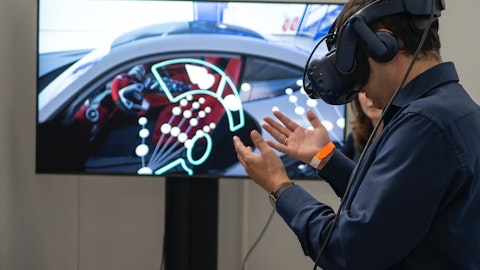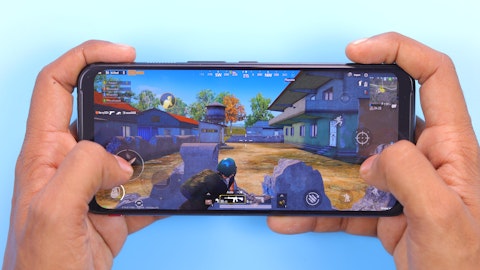Ensemble Capital, an investment management firm, published its “Ensemble Fund” second quarter 2021 investor letter – a copy of which can be seen here. A quarterly portfolio net return of 6.93% was recorded by the fund for the second quarter of 2021, below the S&P Midcap 500 Index that delivered an 8.55% gains for the same period. You can view the fund’s top 5 holdings to have an idea about their top bets for 2021.
In the Q2 2021 investor letter of Ensemble Capital, the fund mentioned Nintendo Co., Ltd. (NYSE: NTDOY), and discussed its stance on the firm. Nintendo Co., Ltd. is a Kyoto, Kyoto, Japan-based consumer electronics company, that currently has a $65.4 billion market capitalization. NTDOY delivered a -14.68% return since the beginning of the year, while its 12-month revenues are up by 24.34%. The stock closed at $68.70 per share on July 21, 2021.
Here is what Ensemble Capital has to say about Nintendo Co., Ltd. in its Q2 2021 investor letter:
“Nintendo (4.4% weight in the Fund): Nintendo’s corporate mission is to “Put smiles on faces of everyone Nintendo touches.” Given the historical cyclicality of Nintendo’s earnings, investors often criticize Nintendo for putting this mission ahead of maximizing shareholder profits. Put differently, they think Nintendo has not pressed its advantage enough when it had the opportunity. There is some element of truth to that, but we consider it a wise strategy. Indeed, delighting its customers is one of the major reasons why Nintendo has remained relevant to video game enthusiasts for nearly four decades while so many of its competitors have since faded into obscurity. It’s thinking in generations while other gaming companies think in quarters.
And by staying relevant, Nintendo won over a generation of 1980s and 1990s children with iterations of hardware and games including Mario, Zelda, and Donkey Kong. Many in this original cohort of Nintendo fans now have their own children, nieces, and nephews with whom they want to share their love for Nintendo’s games. Research from the Entertainment Software Association (ESA) shows that the average age range of a video game player today is 35-44. The previous generation of parents who did not grow up with video games weren’t able to pass down their nostalgia for Nintendo to their children, but this generation is doing just that.
To borrow a line from the TV series, Mad Men, nostalgia is delicate but potent. Nostalgia binds generations. Passion for a particular sports team, for example, is passed from one generation to the next and those happy memories of quality family time carry into subsequent generations. Increasingly, families are turning to video games to create happy memories together. Another ESA survey found that the percentage of U.S. parents who play at least one video game with their children each week increased from 35% in 2013 to 67% in 2017. While we don’t have updated survey results, we believe those figures increased during COVID-related quarantines in 2020.
Nintendo is positioned to capitalize on these trends. Unlike games on more powerful consoles like Xbox or PlayStation, which may have a steep learning curve or unfamiliar characters, both parents and kids recognize Nintendo characters and the learning curves for Nintendo games are low enough where people of any age can start playing and having fun together.
Nintendo’s IP today is in a similar place to where Disney’s was in the 1970s after the Baby Boomer generation started passing down their love for Mickey Mouse, Donald Duck, and other Disney characters to their Generation X children. In 1991, Warren Buffett remarked that Disney’s IP was “like having an oil well where all the oil seeps back in…essentially, you get a new crop every seven years, and you get to charge more each time.” Neither Mario nor Mickey Mouse negotiate for higher contracts and each new twist on the IP is gobbled up by passionate fans.
Not surprisingly, Nintendo wants to provide its fans with a more immersive experience with its characters and worlds. The first Nintendo amusement park, Super Nintendo World at Universal Studios Japan, launched this year and more are planned around the world. Nintendo fans can use their personal Nintendo accounts to connect with the parks’ features for a personalized experience. A Super Mario movie, created in partnership with Illumination Entertainment (known for Minions, Despicable Me, etc.) is slated for a 2022 release. The founder and CEO of Illumination recently joined Nintendo’s board, suggesting that more Nintendo-themed movies are in the works. Other physical world projects include Nintendo flagship stores in major cities and Mario-themed LEGO sets.
None of these projects have a direct impact on Nintendo’s bottom line, but they encourage more engagement with Nintendo’s gaming IP. A key advantage for Nintendo is that it has four decades of game content with which its fans can engage after watching a Nintendo movie or going to a Nintendo amusement park. To illustrate how this can work, after the Netflix series Witcher, which is based on a game developed by CD Projekt Red, became a hit show, demand skyrocketed for legacy Witcher games.
Skeptics argue that Nintendo’s latest hardware iteration, the Nintendo Switch, will follow the course of previous console cycles and start gathering dust in drawers until the next hardware generation is created. We disagree. For the first time in over 30 years, Nintendo is only producing one piece of hardware. Previously, it manufactured two pieces of hardware at the same time – one that’s handheld and another that hooks up to your television. Switch is the best of both worlds and allows Nintendo to focus all its resources – manufacturing, marketing, development, etc. – into one platform. Importantly, Switch has an operating system that can migrate to future hardware iterations, much like the Apple iOS stays with iPhone users as they upgrade every few years.
Another argument in favor of Switch’s durability is that Nintendo is embracing third-party game development, which is a departure from previous hardware cycles. In fiscal year 2020, about half of the gross market value of game sales on Switch came from third-party developers. Nintendo keeps a slice of those sales, but those third-party games maintain high utilization of Switch hardware in between first-party title releases from Nintendo.
Finally, Nintendo’s digital software sales as a percentage of total software sales remain well behind peers like Activision, EA, and Take Two. In fiscal 2021, Nintendo’s digital mix was around 43%, compared with 60-80% for competitors. Some of this difference is attributable to Nintendo games being popular gift items for children’s birthdays and holidays. In the first quarter of Nintendo’s fiscal 2021 (April-June 2020), however, digital sales reached 60% of total software sales, as quarantined families reduced store visits. We think this period made parents more comfortable buying digital games on Nintendo’s eShop. Digital game sales carry much higher profit margins than physical copies do, so even if we were to assume flat software sales for Nintendo in the coming years, gross profits would rise due to the shift toward digital game sales.
Nintendo recently announced a slate of first-party games, including The Legend of Zelda: Skyward Sword, Metroid: Dread, and Splatoon 3, which should keep Nintendo fans engaged with the 85 million Switch units they’ve bought since 2017. Earlier in July, the company also announced a new version of the Switch hardware with upgraded audio-visual components, which will be released this holiday season alongside the new Metroid game. This isn’t a typical hardware cycle for Nintendo and we expect engagement with the Switch to be much more persistent than it has with any previous console generation.”

Barone Firenze / Shutterstock.com
Based on our calculations, Nintendo Co., Ltd. (NYSE: NTDOY) was not able to clinch a spot in our list of the 30 Most Popular Stocks Among Hedge Funds. NTDOY delivered a -5.97% return in the past 3 months.
Hedge funds’ reputation as shrewd investors has been tarnished in the last decade as their hedged returns couldn’t keep up with the unhedged returns of the market indices. Our research has shown that hedge funds’ small-cap stock picks managed to beat the market by double digits annually between 1999 and 2016, but the margin of outperformance has been declining in recent years. Nevertheless, we were still able to identify in advance a select group of hedge fund holdings that outperformed the S&P 500 ETFs by 115 percentage points since March 2017 (see the details here). We were also able to identify in advance a select group of hedge fund holdings that underperformed the market by 10 percentage points annually between 2006 and 2017. Interestingly the margin of underperformance of these stocks has been increasing in recent years. Investors who are long the market and short these stocks would have returned more than 27% annually between 2015 and 2017. We have been tracking and sharing the list of these stocks since February 2017 in our quarterly newsletter.
At Insider Monkey, we scour multiple sources to uncover the next great investment idea. For example, pet market is growing at a 7% annual rate and is expected to reach $110 billion in 2021. So, we are checking out the 5 best stocks for animal lovers. We go through lists like the 10 best battery stocks to pick the next Tesla that will deliver a 10x return. Even though we recommend positions in only a tiny fraction of the companies we analyze, we check out as many stocks as we can. We read hedge fund investor letters and listen to stock pitches at hedge fund conferences. You can subscribe to our free daily newsletter on our homepage.
Disclosure: None. This article is originally published at Insider Monkey.




